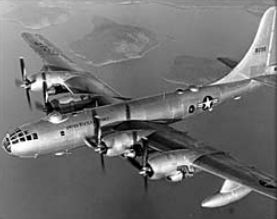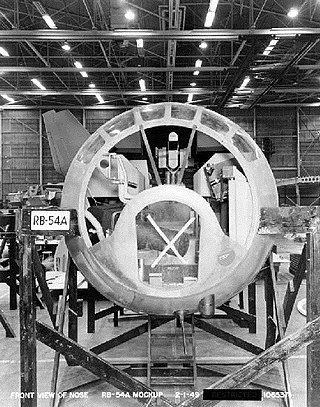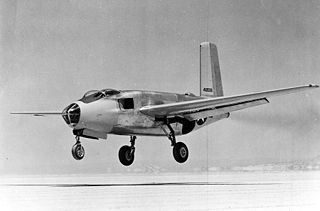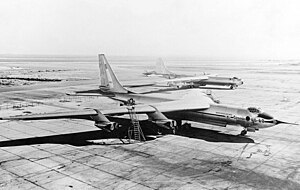
The McDonnell XF-85 Goblin is an American prototype fighter aircraft conceived during World War II by McDonnell Aircraft. It was intended to deploy from the bomb bay of the giant Convair B-36 bomber as a parasite fighter. The XF-85's intended role was to defend bombers from hostile interceptor aircraft, a need demonstrated during World War II. McDonnell built two prototypes before the Air Force (USAAF) terminated the program.

The Convair B-36 "Peacemaker" is a strategic bomber that was built by Convair and operated by the United States Air Force (USAF) from 1949 to 1959. The B-36 is the largest mass-produced piston-engined aircraft ever built. It had the longest wingspan of any combat aircraft ever built, at 230 ft (70 m). The B-36 was the first bomber capable of delivering any of the nuclear weapons in the U.S. arsenal from inside its four bomb bays without aircraft modifications. With a range of 10,000 mi (16,000 km) and a maximum payload of 87,200 lb (39,600 kg), the B-36 was capable of intercontinental flight without refuelling.

The Convair B-58 Hustler, designed and produced by American aircraft manufacturer Convair, was the first operational bomber capable of Mach 2 flight.

The Convair XC-99, AF Ser. No. 43-52436, is a prototype heavy cargo aircraft built by Convair for the United States Air Force. It was the largest piston-engined land-based transport aircraft ever built, and was developed from the Convair B-36 Peacemaker bomber, sharing the wings and some other structures with it. The first flight was on 24 November 1947 in San Diego, California, and after testing it was delivered to the Air Force on 26 May 1949. The Convair Model 37 was a planned civil passenger variant based on the XC-99 but was not built.
The Nakajima G10N Fugaku was a planned Japanese ultra-long-range heavy bomber designed during World War II. It was conceived as a method for mounting aerial attacks from Japan against industrial targets along the west coast and in the Midwest and the northeast of the United States. Japan's worsening war situation resulted in the project's cancellation in 1944 and no prototype was ever built.

The Tupolev Tu-85 was a Soviet prototype strategic bomber based on the Tu-4, an unlicensed, reverse engineered copy of the Boeing B-29 Superfortress. It was the ultimate development of the B-29 family, being over 50% heavier than its progenitor and had nearly double the range. Only two prototypes were built before the program was cancelled in favor of the turboprop powered Tupolev Tu-95 bomber which could cover the same range at a far higher speed.

The Northrop YB-35, Northrop designation N-9 or NS-9, were experimental heavy bomber aircraft developed by the Northrop Corporation for the United States Army Air Forces during and shortly after World War II. The airplane used the radical and potentially very efficient flying wing design, in which the tail section and fuselage are eliminated and all payload is carried in a thick wing. Only prototypes and pre-production aircraft were built, although interest remained strong enough to warrant further development of the design as a jet bomber, under the designation YB-49.

The Northrop YB-49 was an American prototype jet-powered heavy bomber developed by Northrop Corporation shortly after World War II for service with the United States Air Force. The YB-49 featured a flying wing design and was a turbojet-powered development of the earlier, piston-engined Northrop XB-35 and YB-35. The two YB-49s actually built were both converted YB-35 test aircraft.

The Boeing B-50 Superfortress is an American strategic bomber. A post–World War II revision of the Boeing B-29 Superfortress, it was fitted with more powerful Pratt & Whitney R-4360 radial engines, stronger structure, a taller tail fin, and other improvements. It was the last piston-engined bomber built by Boeing for the United States Air Force, and was further refined into Boeing's final such design, the B-54. Although not as well known as its direct predecessor, the B-50 was in USAF service for nearly 20 years.

The Myasishchev M-4 Molot was a four-engined strategic bomber designed by Vladimir Mikhailovich Myasishchev and manufactured by the Soviet Union in the 1950s to provide a Long Range Aviation bomber capable of attacking targets in North America.

The Boeing XB-39 Superfortress was a United States prototype bomber aircraft, a single example of the B-29 Superfortress converted to fly with alternative powerplants. It was intended to demonstrate that the B-29 could still be put into service even if the first choice of engine, the air-cooled Wright R-3350 radial engine, ran into development or production difficulties.

The development of the Convair B-36 strategic bomber began in 1941 with the XB-36, which was intended to meet the strategic needs of the US Army Air Forces, and later of the United States Air Force with its Strategic Air Command. In 1948, the B-36 become a mainstay of the American nuclear deterrent. It underwent a number of design changes before being withdrawn from service in 1959. It was also well suited to high altitude very long range reconnaissance missions, and several alterations were made with this mission profile in mind.

The Convair XB-46 was a single example of an experimental medium jet bomber which was developed in the mid-1940s but which never saw production or active duty. It competed with similar designs, the North American XB-45 and Martin XB-48, all of which saw little use after the successful development of the Boeing XB-47.

The Martin XB-48 was an American medium jet bomber developed in the mid-1940s. It competed with the Boeing B-47 Stratojet, which proved to be a superior design, and was largely considered as a backup plan in case the B-47 ran into development problems. It never saw production or active duty, and only two prototypes, serial numbers 45-59585 and 45-59586, were built.

The Boeing YB-9 was the first all-metal monoplane bomber aircraft designed for the United States Army Air Corps. The YB-9 was a much enlarged twin-engine development of Boeing's single-engine Model 200 Monomail commercial transport.

The Boeing B-54 was an American strategic bomber designed by Boeing for use by the United States Air Force. Derived from the YB-50C Superfortress, construction of the prototype was canceled before completion, and the aircraft was never flown.

Boeing XB-55 was a proposed Boeing aircraft designed to be a strategic bomber. The XB-55 was intended to be a replacement for the Boeing B-47 Stratojet in United States Air Force (USAF) service.

The Douglas XB-43 Jetmaster is an American 1940s jet-powered prototype bomber. The XB-43 was a development of the XB-42, replacing the piston engines of the XB-42 with two General Electric J35 engines of 4,000 lbf (17.8 kN) thrust each. Despite being the first American jet bomber to fly, it suffered stability issues and the design did not enter production.

The Boeing B-52 Stratofortress is an American long-range, subsonic, jet-powered strategic bomber. The B-52 was designed and built by Boeing, which has continued to provide support and upgrades. It has been operated by the United States Air Force (USAF) since the 1950s. The bomber is capable of carrying up to 70,000 pounds (32,000 kg) of weapons, and has a typical combat range of around 8,800 miles (14,080 km) without aerial refueling.
The Douglas 1211-J was a bomber aircraft design developed by American aircraft manufacturer Douglas to compete with the Boeing B-52 design for a major United States Air Force contract between 1946 and 1954. The Model 1211-J design was 160 feet long with a wingspan of 227 feet, and was powered by four turboprop engines. The aircraft was designed around a new 43,000-pound conventional bomb but could carry nuclear weapons as well. It could also carry its own fighter escorts, as parasites under its wings. These fighters' jet engines were to be powered up to assist the carrier bomber during takeoff; refueling of the fighters was to take place while they were stowed on the mothership's underwing pylons.



















